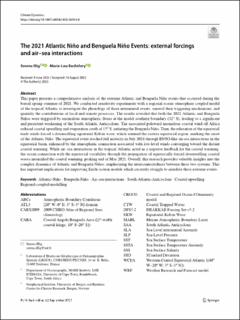| dc.description.abstract | This paper presents a comprehensive analysis of the extreme Atlantic and Benguela Niño events that occurred during the boreal spring–summer of 2021. We conducted sensitivity experiments with a regional ocean–atmosphere coupled model of the tropical Atlantic to investigate the phenology of these interannual events, unravel their triggering mechanisms, and quantify the contributions of local and remote processes. The results revealed that both the 2021 Atlantic and Benguela Niños were triggered by anomalous atmospheric fluxes at the model southern boundary (32° S), leading to a significant and persistent weakening of the South Atlantic Anticyclone. The associated poleward anomalous coastal wind off Africa reduced coastal upwelling and evaporation south of 15° S, initiating the Benguela Niño. Then, the relaxation of the equatorial trade winds forced a downwelling equatorial Kelvin wave, which warmed the eastern equatorial region, marking the onset of the Atlantic Niño. The equatorial event reached full maturity in July 2021 through ENSO-like air-sea interactions in the equatorial basin, enhanced by the atmospheric connection associated with low-level winds converging toward the distant coastal warming. While air–sea interactions in the tropical Atlantic acted as a negative feedback for the coastal warming, the ocean connection with the equatorial variability through the propagation of equatorially-forced downwelling coastal waves intensified the coastal warming, peaking end of May 2021. Overall, this research provides valuable insights into the complex dynamics of Atlantic and Benguela Niños, emphasizing the interconnectedness between these two systems. This has important implications for improving Earth system models which currently struggle to simulate these extreme events. | en_US |

